-
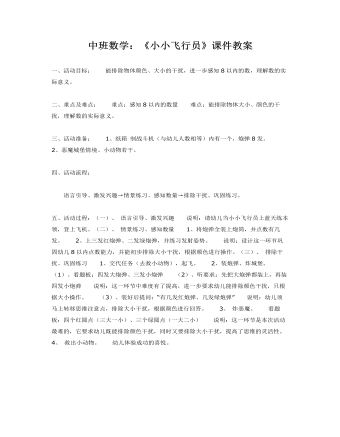
中班数学:《小小飞行员》课件教案
二、重点及难点: 重点:感知8以内的数量 难点:能排除物体大小、颜色的干扰,理解数的实际意义。三、活动准备: 1、纸箱制战斗机(与幼儿人数相等)内有一个,炮弹8发。 2、恶魔城堡情境、小动物若干。四、活动流程: 语言引导、激发兴趣→情景练习、感知数量→排除干扰、巩固练习。五、活动过程:(一)、语言引导、激发兴趣 说明:请幼儿当小小飞行员上蓝天练本领,登上飞机。
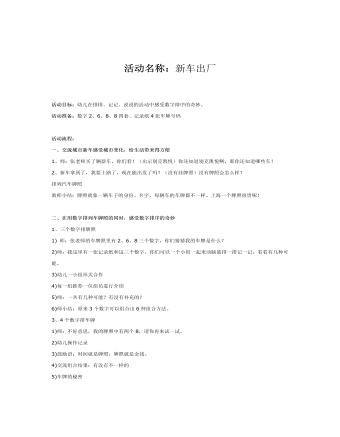
大班数学:新车出厂课件教案
活动准备:数字2、6、8、8四套、记录纸4张车牌号码 活动流程:一、交流城市新车感受城市变化,给生活带来得方便1、师:张老师买了辆新车,你们看!(出示别克凯悦)你还知道别克凯悦啊,那你还知道哪些车?2、新车拿到了,我要上路了,现在能出发了吗?(没有挂牌照)没有牌照会怎么样?排列汽车牌照 教师小结:牌照就象一辆车子的身份、名字,每辆车的车牌都不一样。上海一个牌照很贵呢!
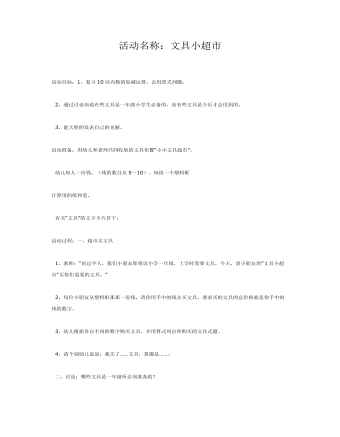
大班数学:文具小超市课件教案
2,通过讨论知道有些文具是一年级小学生必备的,而有些文具是今后才会用到的。 3,能大胆的发表自己的见解。活动准备:用幼儿和老师共同收集的文具布置“小小文具超市”。 幼儿每人一份钱。(钱的数目从5~10)、每组一个塑料框计算用的纸和笔。 有关“文具”的文字卡片若干。
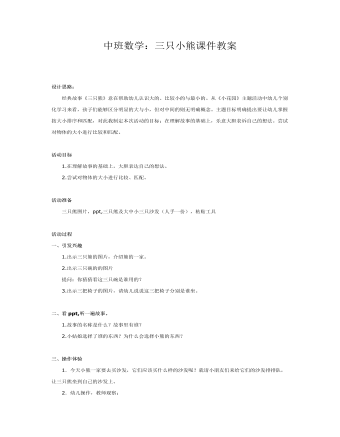
中班数学:三只小熊课件教案
活动目标1.在理解故事的基础上,大胆表达自己的想法。2.尝试对物体的大小进行比较、匹配。 活动准备 三只熊图片,ppt,三只熊及大中小三只沙发(人手一份),粘贴工具 活动过程一、引发兴趣1.出示三只熊的图片,介绍熊的一家。2.出示三只碗的的图片 提问:你猜猜看这三只碗是谁用的?3.出示三把椅子的图片,请幼儿说说这三把椅子分别是谁坐。
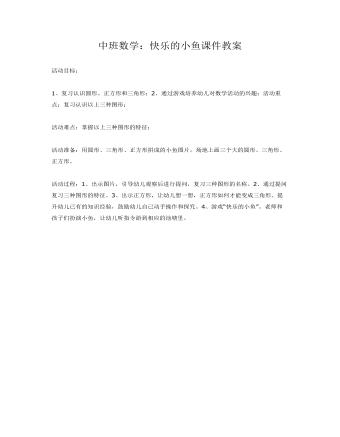
中班数学:快乐的小鱼课件教案
2、通过游戏培养幼儿对数学活动的兴趣;活动重点:复习认识以上三种图形;活动难点:掌握以上三种图形的特征;活动准备:用圆形、三角形、正方形拼成的小鱼图片,场地上画三个大的圆形、三角形、正方形。
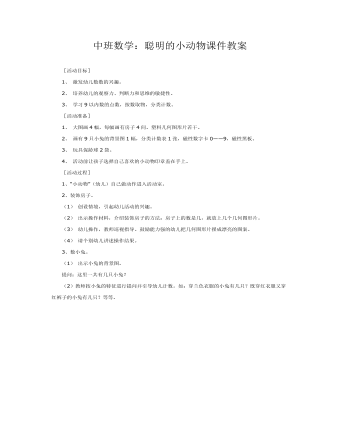
中班数学:聪明的小动物课件教案
2、培养幼儿的观察力、判断力和思维的敏捷性。3、学习9以内数的点数,按数取物,分类计数。 [活动准备]1、大图画4幅,每幅画有房子4间。塑料几何图形片若干。2、画有9只小兔的背景图1幅,分类计数表1张,磁性数字卡0——9,磁性黑板。3、玩具保龄球2袋。
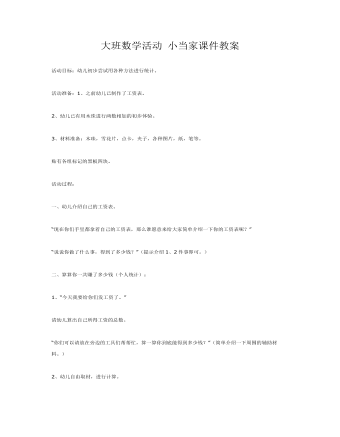
大班数学活动 小当家课件教案
活动准备:1、之前幼儿已制作了工资表。2、幼儿已有用木珠进行两数相加的初步体验。3、材料准备:木珠,雪花片,点卡,夹子,各种图片,纸,笔等。贴有各组标记的黑板四块。活动过程:一、幼儿介绍自己的工资表。“现在你们手里都拿着自己的工资表,那么谁愿意来给大家简单介绍一下你的工资表呢?”“说说你做了什么事,得到了多少钱?”(提示介绍1、2件事即可。)
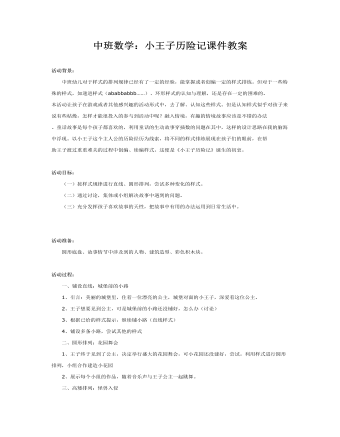
中班数学:小王子历险记课件教案
活动目标: (一)按样式规律进行直线、圆形排列,尝试多种变化的样式。 (二)通过讨论,集体或小组解决故事中遇到的问题。 (三)充分发挥孩子喜欢故事的天性,把故事中有用的办法运用到日常生活中。 活动准备: 圆形底盘、故事情节中涉及到的人物、建筑造型、彩色积木块。 活动过程: 一、铺设直线:城堡前的小路1、引言:美丽的城堡里,住着一位漂亮的公主,城堡对面的小王子,深爱着这位公主。

大班数学:小蜻蜓捉害虫课件教案
2、在操作活动中不断探索数的多种分法,并学会记录。3、发展动手操作能力及多维度思维能力。活动准备:教具:稻田背景图一张,木珠做成的虫子一条,刀笔一只,记录卡一张,练习卡片若干。 学具:木珠做成的虫子若干,记录卡人手一份,刀笔人手一份。
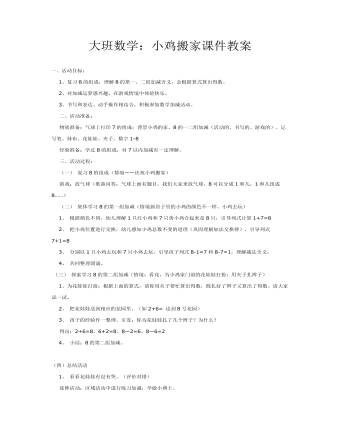
大班数学:小鸡搬家课件教案
2、对加减运算感兴趣,在游戏情境中体验快乐。 3、书写和表达、动手操作相结合,积极参加数学加减活动。 二、活动准备: 物质准备:气球上打印7的组成;背景小鸡的家、8的一二组加减(活动的、书写的、游戏的)、记号笔、抹布、花娃娃、夹子、数字1-8 经验准备:学过8的组成,对7以内加减有一定理解。 三、活动过程: (一)复习8的组成(情境——庆祝小鸡搬家) 游戏:放气球(歌曲问答:气球上面有题目,我们大家来放气球,8可以分成1和几,1和几组成8……)
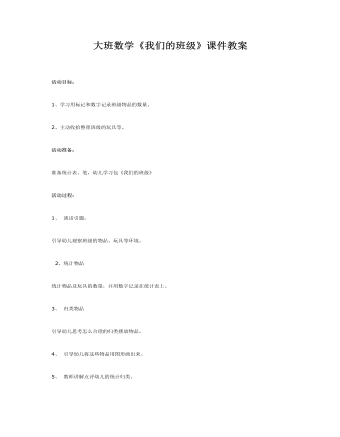
大班数学《我们的班级》课件教案
2、主动收拾整理班级的玩具等。活动准备:准备统计表、笔,幼儿学习包《我们的班级》活动过程:1、 谈话引题。引导幼儿观察班级的物品、玩具等环境。 2、统计物品统计物品及玩具的数量,并用数字记录在统计表上。

人教版新目标初中英语七年级上册Can you play the guitar教案
本单元主要是学习情态动词can的肯定句、否定句、一般疑问句,肯定与否定回答,以及特殊疑问句的构成和用法;复习what弓!导的特殊疑问句。本单元主要围绕“加人俱乐部,谈论自己的能力”这一话题,设计了三个任务型活动:任务一是:自己的才艺表演,学习情态动词can的用法;任务二是:自己建立俱乐部,运用情态动词can谈论自己在某一方面的能力、喜好和意愿;任务三是:我能成功,主要是复习巩固谈论各自的爱好和特长的方法。单元知识系统(树)Can you/he/she/you dance? 一Yes,I/he/she/we can./No,I/he/she/we can’t.Can Bill play the guitar?一Yes,he can,but he can’t sing.单元总体目标通过学习情态动词can的用法,使学生能够表达自己在某一方面所具备的才能;能够谈论自己的喜好与意愿;能够为自己成立的各种俱乐部制作海报;会写招聘广告。单元重难点一览重点 难点I.复习词汇:can,play,want2.词汇:guitar, dance, swim,sing, chess, speak, drum,trumpet,violin,play the guitar3.句型:Can you/he/she/you dance?Yes,I/he/she/we can./No,I/he/she/we can’t.Can Bill play the guitar?

人教版新目标初中英语七年级上册Do you have a soccer ball教案
在这一单元中,学生要学会就有关人与物之间所属关系进行问答的句子。本单元大量引入有关运动的名词,要求学生彼此询问有无此类物品,并做出相应的回答。 同时学习表示建议的句型Let’s运动的形容词。 本单元所选用的话题来自学生所喜欢的生活片段,在教学中生生交流、师生交流会更融洽,会促进师生彼此间的了解,成功的教学还会让部分学生养成良好的运动习惯和收藏习惯。 教学目标 1) 语言知识:A.在询问对方是否有某物的对话中学会使用do和does引导的一般疑问句; B. 学会使用描述性的形容词来评价事物; C. 学会在对话中使用名词复数; D. 学会用祈使句来向对方提出建议. 2) 语言技能:A. 学会用祈使句询问某人是否有某物; B. 学会向他人提出建议的句子. 3) 学习策略:A.通过与同学讨论,做出猜测;

人教版新目标初中英语七年级上册How much are these pants教案
个性练习设计 阅读广告:在日常生活中,人们去买东西之前,一般要阅读广告,从广告中获取该商品的一些有用信息,包括价格、性能等。所以给学生提供有些商品的广告或让学生去商店去阅读一些商品的广告,从中获取商品的价格,即可以锻炼学生的阅读能力,又能提高实践能力。 Self Check 教学内容 Self Check(教材P42) 教学目标 知识与能力 复习词汇pant,sock,T-shirt,sweater,shoes,color,black,white,red,green,blue,big,short,long,数字10--31; 学习词汇Zig Zag,clothes,shop,yellow,ask,which;学会谈论服装的价格、颜色、大小和长短;学会填写价格标签。 过程与方法 运用Summarizing和Classifying的学习策略。在复习教学中,运用听写、绘画、互相询问调查与检测等手段,促使学生不断地使用所学内容,从而提高他们灵活运用知识的能力。 情感态度价值观 该部分学习内容主要是复习谈论服装的价格和颜色以及对服装的喜好,能引起学生的共鸣;通过购物的对话练习教学生学会购物时使用的礼貌用语和如何感谢人。

人教版新目标初中英语七年级上册What time do you go to school教案
知识与能力复习词汇time,morning,breakfast,get up,g0 t0 bed,homework,clock,afternoon,lunch,run,watch TV,evening,dinner,eat,usually,o’clock,thirty,fifteen,take a shower,go t0 school等;引导学生复习、巩固“询问和谈论时间”的目标语言并运用所学知识安排自己的学习和课外活动。过程与方法运用Summarizing,Classifying和Comparing的学习策略。在复习教学中,运用听写、提问、对话演练与调查活动,促使学生不断地使用所学内容,从而提高他们灵活运用知识的能力。情感态度价值观本部分的主要内容是复习“日常作息时间”的询问和表达。通过互相询问或谈论自己或对方的作息时间安排和活动计划,培养学生良好的作息习惯和守时习惯。教学重、难点及教学突破重点复习词汇time,morning,breakfast,get up,g0 to bed,homework,clock,afternoon,lunch,run,watch TV,evening,dinner,eat,usually,o’clock,thirty,fifteen,take a shower,go to school等;引导学生复习、巩固“询问和谈论时间”的目标语言。

人教版新目标初中英语八年级上册Can you come to my party教案3篇
Step 3 (3b)First, tell the students when we talk about our future plans, we often use: I’m+verb+ing When we talk about what we must do, we use have to. Ask the students to fill in the blanks in 3b. The answers are: shopping, go to see, a test, I’m going, my family. Step 4 (3c)Let the students write an e-mail message to a friend. Say why you can’t visit next. Before the exercise, ask the students to give some possible answers and write them on the blackboard. So the students will feel easy to finish the writing exercise. After they finish it, Let them to correct it in groups first. Each group chooses theirs best one to read in front of the whole class. Step 5 ( planning a party )First read the conversation in the box together. Then ask the students to turn to page 88.Write down everything you have to do next week. Write in all the things you have to do . Ask the students to look at the list. Ask them “What day are you free?” This is when you can have your party. Step 6 (Self check 1 )Let the students to fill in the blanks with the words given. Change the forms of the words if possible. Then make their own sentences. The answers are: visit, playing, have to, study, comeStep 7 (Self check 2)Imagine you are Marie. Read the information and look at your schedule. Write replies to the invitation.

人教版新目标初中英语八年级上册Could you please clean your room教案3篇
一、 教学内容Section A 1a----1c二、 教学目标1.学习词汇do the dishes, make the bed, take out the trash, fold the clothes, do the laundry, sweep the floor, clean the living room.2.句型 Could you please clean your room? Yes, sure.三、 教学准备 学生预习本单元所有的词汇多媒体课件 活动表 奖品四、 教学过程Pre-task1. Warming upEnjoy ourselves. Watch cartoon Cinderella. 看动画片段《灰姑娘》导如入本课话题和新词汇“chores”美丽善良的鬼姑娘因继母的嫉妒,每天得做所有的家务。片段的主题使学生联想到本课的话题。2. learn new words and phrasesLook! What is she / he dong? 看图学习动词词组do chores, do the dishes, make the bed, take out the trash, fold the clothes, do the laundry, clean the living room.3. Guessing game.What is she doing ? 4. Pair work. 1a, Do you do these things at home? Write “Y” for “yes” and “N” for “no”.5. Listening . 1b , Peter’s chores or Mom’s chores?理解目标语Could you please clean your room? Yes, sure.Write “M” for Mom’s chores, “P” for Peter’s chores in the chart.6. PairworkLook at the picture,Ask your partner to do the chores that you see. 7. Interview Who is the most able at home? 1) What chores do you do at home? How often do you do the chores? Work in four, interview each of the students in the group, fill in the chart.

人教版新目标初中英语八年级上册How do you get to school教案2篇
Step Ⅶ Role play ( Work on 1b)1. First ask two students to read the dialogue to the class.Sa: How do you get to school?Sb: Well, I ride my bike to the subway station. Then I take the subway.2. Now work with a partner.Suppose you use two kinds of transportation to get to school \Hangzhou\Beijing... (bus, train, subway, walking, bike, etc.) Tell how you get there. You may use the phrases in 1a.3. Then ask different pairs of students to present their conversations to the class.Step ⅧListening1. Work on 2a(1) First ask students to read the list of information that Thomas wants to know.…where Nina lives.…how far from school she lives.…how long it takes to get to school.…how she gets to school.…what she thinks of the transportation.(2) Tell students what transportation and bus stop mean.bus stop 汽车站 transportation n. 运送;运输Then tell students we'll hear a recording. Please put a checkmark in front of each thing that Thomas wants to know.(3) Now play the recording for students.( Have students pay attention to the sample answer.) (4) Then correct the answers.

人教版新目标初中英语八年级上册What are you doing for vacation教案2篇
Teaching goals : 1. Words & phrases: babysit ,get back , fishing , rent , think about , decide(on) , tourist etc. 2. How to talk about future plans . 3. 现在进行时表示将来计划或行动. 4. 特殊疑问句(where , when , how long引导) Important and difficult points : Drills :What are you doing for vacation ? I’m watching TV . When are you going ? I’m going … . How long are you staying ? We’re staying for five days . Teaching aids : cards and a tape ,a large wall calendar . Period 1 Teaching procedures : Step 1Leading in1. Free talk . 2. Put up the wall calendar . T: I’m staying home on Saturday (pointing to next Saturday ).Ss repeat . Ss: I’m staying home on Saturday . T: OK. Today we’ll learn how to talk about future plans. Step 2Pre-task SB Page 13 , 1a . 1. Look at the picture carefully and tell what you see in the picture . 2. Write the activities from the pictures in the box and add some more . 3. Practice reading . Step 3While-task1. Using the activities we write in 1a to make conversations .For example :What are you doing for vacation ? I’m visiting my uncle . 2. Pairwork .Practice in pairs . 3. 用第三人称练习对话.

人教版新目标初中英语八年级上册I’m going to be a basketball player教案3篇
教学目标1.知识目标:(1)学习What are you going to be when you grow up?/How are you going to do that?句式。(2)学会用英语描述有关职业的表达法。2.能力目标:(1)能够谈论为实现理想所做出的打算和安排。(2)能够谈论未来自己与他人理想的职业及原因。(3)能用英语描述课余时间的活动安排,最终具备表达综合信息的能力。3.情感目标:新学期到来之际,让他们在学习、体育、饮食、特长、读书等方面制定计划,教育学生合理安排自己的课外生活,思考自己的理想职业及适合自己的职业。教学重点、难点本单元的重点为“be going to”表将来,want to be, what,where, when,how引导的特殊疑问句。难点是语言目标的实现。教材分析本单元以I am going to be a basketball player为话题,共设计了三部分的内容:一、Section A该部分有4个模块。第一模块围绕Do you think these jobs are interesting?这一话题展开思维(1a)、听力(1b)、口语(1c)训练;

